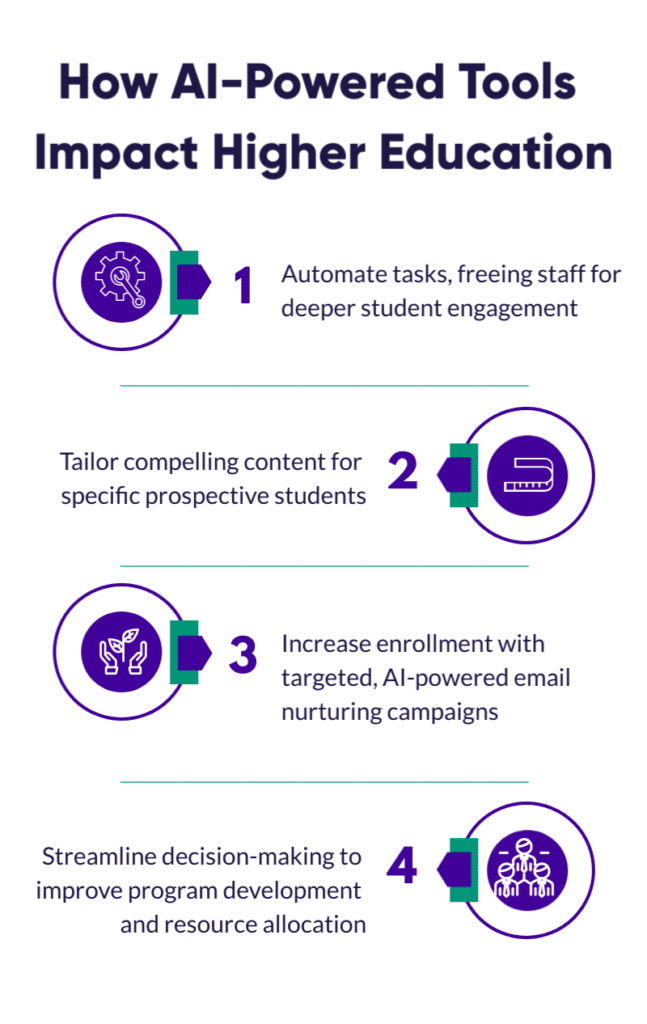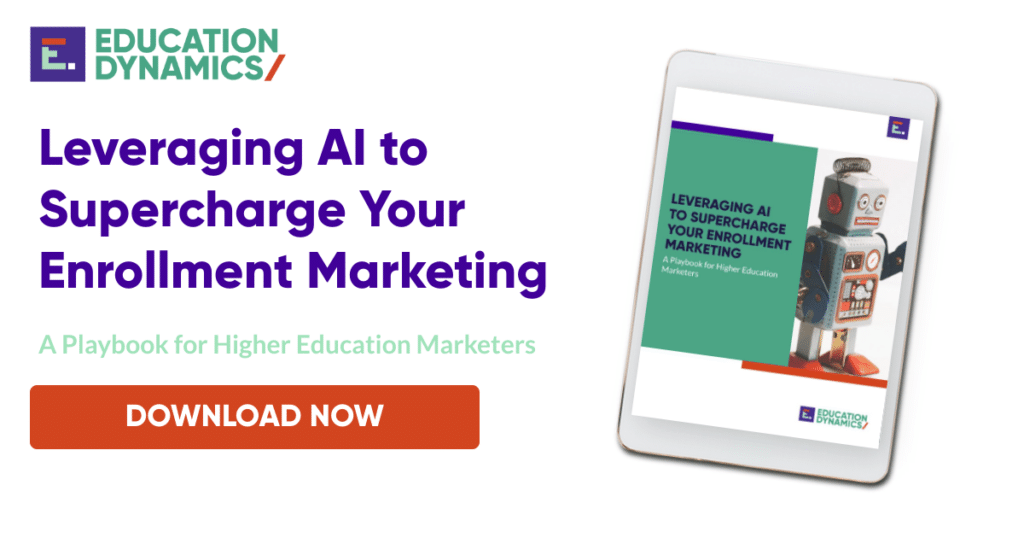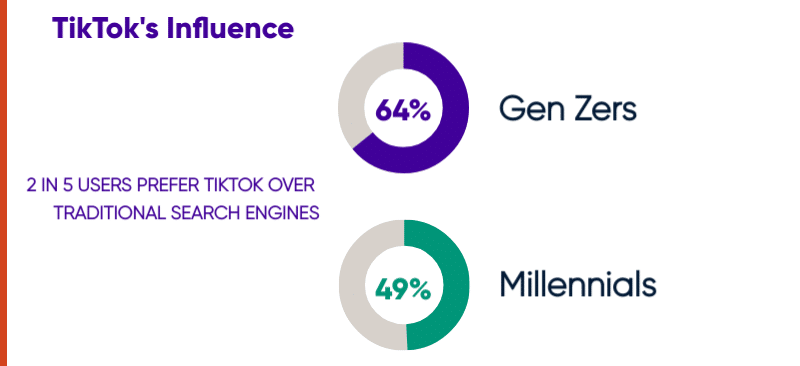2024 Higher Education Digital Marketing Trends and Predictions

Higher education is facing a whirlwind of change. Technology is experiencing rapid growth with the increased adoption of AI. The workforce’s needs are changing. Students now seek high-value education, relevant work experience, and flexibility in their expectations.
Change can be overwhelming, but it drives innovation. Linear decision-making is a thing of the past. Prospective students now use diverse touchpoints for non-linear, multi-channel information gathering and decision-making.
2024 promises a student journey driven by AI-powered automation, personalized messaging crafted from rich first-party data, and targeted outreach amplified by a surge in paid social advertising. Change is inevitable, but let’s make it intentional. Get ready for a student engagement paradigm shift. Institutions with effective tools will smoothly guide students through enrollment in this data-driven landscape.
Here’s a list of key trends and predictions to guide your strategy:
The Evolution of Match Types
The depreciation of broad match modifiers in 2021 has led marketers to shift their keyword strategy and rely more heavily on Google’s algorithm to make keyword-matching decisions. With less control over which search queries trigger an ad, negative keywords have become even more crucial in filtering out irrelevant traffic for improving ad targeting and minimizing wasted spend.
This also highlights the importance of having a strong and relevant landing page that is aligned with the targeted keywords. With more potential variations triggering an ad, a landing page that best matches the intent of the search query will improve the overall ad performance and quality score while delivering a better user experience for prospective students.
Prediction: Google will likely sunset another match type, and phrase match may be next in queue. Which means that there will be rise in broad match and landing page content will become more important in Google’s algorithm.
AI: The Conversion Kingmaker

AI technology has significantly impacted the way higher education institutions approach marketing and recruitment. With AI-powered tools, tedious processes can be automated, assist in the collection and analysis of vast amounts of data, and improve the overall efficiency and effectiveness of marketing campaigns.
Some examples of AI-powered tools impacting higher education include:
- Improve operational efficiencies and minimize errors within an enrollment team by implementing AI-powered automation tools for rapid execution of repetitive tasks, freeing up resources to concentrate on student-related matters.
- Enhance the student experience with compelling content and visuals that resonate with prospective students at different stages of the funnel, creating a more engaging experience.
- Increase the likelihood of students enrolling with AI-powered nurturing campaigns that can analyze user behavior and engagement to send targeted and timely emails.
- Streamline decision-making in areas such as program development, expansion, or technology adoption by leveraging AI insights to evaluate different scenarios and their potential impacts on institutions.
How will Generative Search Experience (SGE) impact Higher Education Ads?
Generative Search Experience (SGE) is another example of AI that may impact higher education digital marketers. It incorporates AI into the search engine results page by using advanced algorithms and machine learning techniques to provide the user an answer to their query as opposed to showing a set of links for users to click on.
At its core, generative search experience, aims to improve the user experience by providing more relevant and personalized results. However, this shift may impact the way ads appear on the search engine results page resulting in institutions appearing lower on the page or less often.
Navigating SGE’s impact requires a strategic shift in targeting and ad strategies. Higher ed marketers should consider the implications of generative AI in search.
The EducationDynamics AI Playbook is a valuable resource, offering guidance on navigating risks and implementing best practices in AI-driven marketing. Emphasizing considerations and best practices becomes crucial for marketers optimizing strategies in the evolving SGE landscape.
Prediction: AI-powered tools will become increasingly instrumental in optimizing conversions, fostering improved targeting, and enhancing overall marketing performance.

TikTok’s Influence
Forget grainy flip phones and endless aisles – just as smartphones made photography accessible to everyone and Amazon redefined our shopping habits, TikTok is ushering in the next wave of technological disruption.
TikTok’s popularity has shaped content and engagement on other platforms, inspiring the adoption of short-form, visually engaging features across various social media platforms. Its impact reaches beyond its platform, shaping content across social media. As a powerful search engine for Gen Z, it quietly transforms higher education marketing.
2 in 5 users now prefer TikTok over traditional search engines, attracted by its bite-sized, information-packed videos. This shift towards digestible content is undeniable. The platform’s storytelling strength and personalized content also resonate with prospective students, making it a goldmine for institutions to connect and engage.
Here’s why and how universities can leverage this trend to their advantage:
- Create concise, informative, attention-grabbing content that addresses student concerns and showcases campus life.
- Collaborate with influencers with a strong following to promote campus events, activities, and the institution’s brand.
- Explore paid advertising options on TikTok to reach a larger audience through advanced targeting and creative content.
- Tap into educational hashtags to create authentic and educational content that resonates with prospective students.
- Showcase an authentic and genuine look at your college or university.

Prediction: TikTok’s impact on content formats and user engagement may lead to a sustained shift in how institutions approach digital marketing. The preference for short-form, visually engaging content is likely to persist, with universities increasingly using TikTok to connect with prospective students.
First-Party Data: The New Cookie Jar
Cookie deprecation and the shift toward first-party data
In the swiftly evolving landscape of higher education marketing, a bold prediction emerges: Embrace data privacy, build trust, and attract the best students, as first-party data becomes the strategic weapon for success in a cookieless era. Rather than a setback, this shift offers marketers an opportunity to pivot their strategies toward a more direct and personalized approach.
Limits on third-party tracking cookies create challenges in understanding prospective students’ online behaviors for precise campaigns. Yet, the surge of first-party data collected with consent becomes a guiding light for marketers. This reliable data addresses privacy concerns and empowers institutions to engage with unparalleled precision. It opens avenues for meaningful connections through owned channels like websites, apps, and emails.
Facebook’s Lead Ads effectively tackle challenges posed by cookie depreciation. They streamline sign-ups, boost personalization, and provide valuable customer insights. Prioritizing these ads is a strategic move for robust first-party data in higher education marketing.
With expertise and proven solutions, EducationDynamics is your trusted partner in building a future-proof marketing strategy powered by first-party data. As a Google Premier Partner, we have exclusive access to Google’s resources, empowering your team to leverage first-party data for transformative results strategically.
Prediction: The use of Lead Ads is expected to continue growing as more marketers recognize the benefits of this advertising format.
Video Storytelling to Captivate and Convert
With spending reaching $99.4 billion in 2024, short-form video ads cement their power to deliver messages and win audiences.
There are many ways to engage students, and choosing the right format for your messaging can make all the difference. Each format has its own unique advantages and can help you achieve specific goals.
- Short-form: Grabs attention quickly, popular for sharing bite-sized content. Enhances time on the page and visitor engagement.
- Live: Engages audiences in real-time. Allows interaction, answering questions for an authentic and immediate connection.
- Interactive: Involves viewers with choices or interactions on the screen. Highly engaging and effective for driving user interaction.
It’s important to consider the platform and the student audience when determining the most effective video format for a particular use case. And most importantly, create compelling video stories that resonate with your audience.
We’re wired for stories. The human brain connects emotionally and retains information through narratives. Stories about how higher education institutions can add value to their student’s lives by helping them achieve their personal and educational goals will motivate prospective students to move further down the funnel.
Create captivating video stories by emphasizing emotion and the big picture. Ensure relatability and engagement through shared human experiences. Incorporate conflict and direct communication while maintaining conciseness and authenticity. Understand your students’ needs to make your video stories more likely to captivate and resonate.
Prediction: Short-form videos are expected to see the most growth among different marketing strategies. Marketers will invest more in short-form videos than any other content format.
Changing Audiences: Adapt or Get Left Behind
Ethical considerations, automation goals, and performance optimization drive significant changes in advertising platform targeting. Platforms like Meta (formerly Facebook), LinkedIn, and others are undergoing transformative shifts in their targeting options.
- Meta is removing or combining detailed targeting options related to sensitive topics like health, race, and ethnicity. This move aims to improve automated ad targeting tools, emphasizing broader targeting and Advantage+ options.
- LinkedIn is discontinuing Lookalike Audiences due to limited usage and platform improvement.
- Google discontinued the “similar audiences” targeting option, encouraging a shift to advanced, automated audience solutions like optimized targeting and Smart Bidding. Advertisers adapt by leveraging first-party data for privacy-focused marketing.
These changes signify a shift towards responsible and automated targeting, addressing past controversies and enhancing ad performance. Effective marketing necessitates understanding your audience, employing segmentation, and embracing personalization.
Staying informed about cultural shifts and social movements is crucial, influencing how platforms categorize targeting options. Aligning strategies with current sensitivities enhances overall advertising effectiveness.
Prediction: Marketers can anticipate shifting towards broader, more inclusive targeting tools and increasing advanced, automated solutions.
Paid Social: More Bang for Your Buck
Social media advertising spending is rising, with projections nearing $220 billion by 2024. This impressive growth largely stems from its proven effectiveness, prompting various players, including higher education institutions, to jump on board.
Educational institutions leverage paid social media to promote their academic offerings, campus culture, and additional services. They employ targeted advertising strategies, aligning content with specific user demographics and behaviors for greater impact.
This increasing demand has incentivized major platforms to introduce and invest in paid advertising models, solidifying its role as a worthwhile investment for boosting social media presence and reaching wider audiences.
What are the advantages of paid social media advertising for optimizing campaigns?
Paid social media advertising offers enticing advantages.
- Increased Reach
- Improved Targeting
- Greater Content Visibility
- Enhance Brand Awareness
- Customization and Flexibility
Measuring ROI in paid social media is crucial for proving value, making informed decisions, and optimizing campaigns. It identifies successful strategies, justifies budgets, and allows for adjustments based on metrics like reach and engagement, ensuring optimal impact.
Prediction: As major platforms continue to invest in and introduce paid advertising models, marketers will likely find increased opportunities for customization and flexibility in their strategies.
Capture Attention with Image-Based Snippets
Forget endless rows of blue links – In recent years, Google’s Search Engine Results Page (SERP) has blossomed with image thumbnails alongside textual entries.
These images, selected by Google’s algorithms, aim to assist users in choosing which results to click on. While there is no direct control over the images shown, optimizing them—selecting the best format, compressing, naming, and including alt text—can enhance their visibility in search results.
To optimize images for better ranking and visibility, consider the following strategies:
- Use descriptive and concise file names.
- Reduce file size without compromising quality.
- Select the appropriate file format based.
- Add descriptive alt text.
- Optimize the dimensions of the images to reduce load time
- Compress image files.
- Optimize image resolution and quality.
Great visuals boost image and video search visibility, attracting more organic traffic to the site. Google prefers optimized images, considering factors like file names, alt text, and relevance. These elements enhance search visibility, which is crucial for a comprehensive SEO strategy. As you enhance your website’s content, remember that optimizing visuals is key to a strong SEO approach.
Prediction: The importance of visual content for SEO will grow, with marketers recognizing the impact of image-based snippets on search rankings.
Google Ads’ Optimization Score
Every marketer aims to get more out of their budget. Harnessing the Google Ads Optimization Score streamlines the process by identifying strengths and weaknesses in your campaigns. It reviews your campaigns, offering personalized recommendations for better performance and reduced spending. Think of it as a complimentary audit with guaranteed returns.
What happens when you apply or dismiss a Google Ads Optimization score recommendation?
Accepting or rejecting a Google Ads Optimization Score suggestion impacts your account’s performance and overall score. Keep in mind that these suggestions aren’t strict rules; consider each in relation to your campaign strategy and business goals
Discover the effects of your decisions on your account’s performance with Google Ads Optimization Score guidance:
Applying Recommendations of Optimization Scores
Advantages
- Improved Performance: Some types enhance campaign performance and save time, potentially increasing profits.
- Optimization Score Impact: Positively affects your account’s score, aligning proactively with Google’s suggestions.
Disadvantages
- Over-automation: Automation may not align with the overall strategy, requiring human judgment
- Limited Understanding: Some recommendations may conflict with your established practices
- Potential Impacts on Ad Spend: Certain recommendations, like CPC bid changes, could increase ad spend.
Dismissing Recommendations of Optimization Scores
Advantages
- Unique Customization: Tailor ad copy, target CPA, and strategies to your unique vision.
Disadvantages
- Optimization Score Impact: Ignoring certain recommendations may neutrally or negatively affect your optimization score, signaling a choice to pass on potential optimizations.
- Potential Missed Opportunities: Dismissing recommendations without careful thought can hinder performance improvement.
- Lack of Future Relevance Assessment: Ignoring recommendations may overlook beneficial adjustments, especially if they become relevant later.
- Influence on Aggregate Score: Dismissing recommendations affects the optimization score. While not all need blind acceptance, consider the impact of dismissal on the overall score.
What is Google Ad Quality Score?
Beyond clicks and budgets, Google Ads introduces the Quality Score—a metric revealing your keywords and ads’ relevance and quality. Google refines search results to eliminate poor content and boost high-quality content on SERPs. Low Quality Scores can lead to reduced organic rankings, conflicting with Google’s goal of promoting accurate and unique content.
Yet, Quality Score isn’t the sole factor of campaign success. Use it as a diagnostic tool to improve user experience and ad relevance, aligning with long-term goals. While a higher Quality Score enhances PPC results, maintaining balance with your overall PPC strategy is crucial.
Prediction: Google may start penalizing accounts with low Quality scores due to its commitment to providing users with the best search experiences possible.
One Size Doesn’t Fit All
The student journey is complex, demanding targeted, personalized marketing to connect with both prospective and current students. Utilizing data and analytics is key, delivering tailored content, recommendations, and offers at every stage of their decision-making process.
Imagine: instead of generic emails, students receive information relevant to their specific interests, concerns, and progress in the application or enrollment process.
This journey-based approach extends beyond basic segmentation, enabling personalized touchpoints such as targeted social media ads at crucial moments—from initial awareness to application submission and beyond. Techniques like real-time personalization, cross-selling, and upselling further refine the experience based on individual behavior and preferences.
Future personalized marketing, driven by AI and machine learning, promises hyper-personalized experiences tailored to individual student needs. This surpasses “one size fits all,” creating human-like connections across channels and stages.
In short, personalized marketing isn’t just a trend; it’s the key to navigating the complex student journey and building lasting relationships with future generations of learners.
Prediction: Higher education marketers will increasingly adopt personalized marketing strategies to connect with prospective and current students, recognizing the complexity of the student journey.
Propelling Your Marketing: Shifting Gears, Building Foundations, and Targeting Transformation
The higher education marketing landscape is abuzz with exciting trends and predictions, creating a fertile ground for institutions to truly shine. With constant changes, staying ahead and attracting top students is an opportunity for higher education marketers and professionals to take advantage of.
Let’s break down the key trends you need to know to future-proof your strategies:
Shifting Gears: Update your negative keyword lists to minimize wasted spend and optimize landing pages to better align with targeted keywords to improve overall ad performance and quality score. Use AI for automation and conversion optimization. Embrace TikTok for captivating short-form video storytelling.
Building Foundations: Prioritize first-party data in the post-third-party cookies era. Use Lead Ads for data and personalized outreach. Optimize visuals for SEO. Analyze Google Ads’ recommendations in line with your campaign goals.
Targeting Transformation: Prepare for broader targeting options as platforms shift. Invest wisely in paid social media advertising for customization and engagement. Prioritize personalization using data, analytics, AI, and machine learning to tailor marketing efforts to individual student needs and preferences.
Remember, this is just the beginning. The journey to standing out in 2024 requires exploration, experimentation, and a willingness to embrace change.
EducationDynamics is your partner in this exciting journey. Let our digital marketing experts assist in implementing new strategies, analyzing data, and creating personalized campaigns for your prospective students. Reach out to EducationDynamics today, and let’s discuss how we can collaboratively propel your marketing goals in 2024 and beyond.